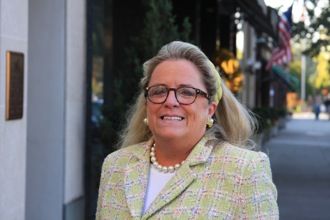From The Mayor: Bronxville's Goals at NY State Conference of Mayors 2022

By Mary Marvin, Mayor of Bronxville
Jan. 22, 2022: This is the time of year when Village Administrator Jim Palmer and myself head to Albany with our fellow village managers/administrators and New York mayors to lobby for the priorities of the New York State Conference of Mayors 2022 Legislative Program.
In an incredibly bipartisan effort, the program is developed and approved by official’s state wide who share the common objective: to provide local leaders with the resources and discretion to deliver municipal services in the most effective and responsive manner for the taxpayers we serve.
Our own Village Administrator, Jim Palmer, has a major role in this year’s deliberations as he is President of the New York State City/County Management Association and serving as the Affiliate Representative on the NYCOM Board, quite frankly an honor bestowed on only those of great skill and experience.
Our first goal has been for at least 15 years plus to increase State Aid by sending money back to the cities and villages.
The re-investment of state tax revenues back to the municipal governments that support the generation of such tax revenue is essential to the strength of our communities, the retention and growth of the alarmingly declining New York State population base and the lowering of the property tax burden on our residents. Unlike aid to schools, which has increased every year, New York State has failed to increase this essential reinvestment to municipalities for an astonishingly 13 years.
Number two on the list in terms of importance is to provide dedicated funding for local water and sewer infrastructure. Since 2017, the state has provided millions of dollars in grant money through a Clean Water Infrastructure Act to help municipal governments address water emergencies in particular. Sadly, local officials have found that funding is not readily available for upgrades or preventive maintenance, rather applicants need to demonstrate an emergency situation and not simply the need to prevent an emergency. In essence, the program rewards communities who ignore preventive maintenance and then reach out for funds requiring double and triple the cost of repair if the issue has been dealt with through an intelligent infrastructure capital plan.
Our group, NYCOM, supports the establishment of an annual funding stream that could be used by all cities and villages to supplement water infrastructure operation and maintenance costs which would help to prevent more significant and costly emergency situations and repairs.
As a yearly occurrence, the State sends money to improve roadways based on a formula related to local highway mileage and vehicle traffic. Whatever the amount received locally has been passed vastly surpassed by the additional costs incurred by state mandates. As example, the recent ADA requirements to provide curb ramps to ensure access to sidewalks and all pedestrian walkways is an undertaking in the millions. This very understandable and necessary change became law with no additional state funding and impacts most severely small communities that are highly walkable.
While the 2% tax cap, initiated by former Governor Cuomo, was to control the growth of property tax levies, as municipal officials we have all identified significant unintended consequence that have developed particularly with respect to economic growth. We should be able, as school districts, are to have the ability to invest in infrastructure and promote revitalization without it affecting the tax cap. We advocate the tax cap be amended to exclude municipal expenditures relating to public infrastructure in the same way it applies to school districts as it now serves as a disincentive for preventive maintenance.
Not at the top of the list but truly an endemic problem is the need to amend the civil service appointment process which is arcane at best. The civil service system truly hamstrings local officials when trying to hire the person that would best fit a particular community.
For example, there is a provision called “the rule of three” which means the top three scorers, solely on a written exam, must be hired before you can touch the dozens of other people on the list regardless of whether these folks have the personality, the social IQ or the skill set needed in your particular community.
Bronxville has personally waited months and months with the hope that the top three exam scores get jobs so we can hire the person who would most fit our needs. The system doesn’t make sense and honestly it’s not in the best interest of the taxpayers that these candidates are hired to serve.
An issue that is in the papers on a daily basis is the State bail reform law enacted in 2019. While the purpose of bail is to ensure that defendants return to court for subsequent court proceedings, it has also historically provided the ancillary benefit of keeping dangerous individuals off the streets. However, under the new law, judges have limited ability to consider public safety as a factor in making bail determination. The Mayors’ Association supports the law being amended to clearly allow New York’s criminal court judges to consider the danger that defendants pose to the public when weighing the option of setting bail. In making such a determination, judges should be required or at least allowed to take into account prior record, the strength of the case and the nature of the current offense. Such is not the case currently.
As mayors and administrators our batting average as to reforms enacted wouldn’t even get us to the minor leagues but we press on with the hopes that as the electeds change, perhaps the needs of local government may become a priority.
Government & History Directory
Bronxville is a quaint village (one square mile) located just 16 miles north of midtown Manhattan (roughly 30 minutes on the train) and has a population of approximately 6,500. It is known as a premier community with an excellent public school (K-12) and easy access to Manhattan. Bronxville offers many amenities including an attractive business district, a hospital (Lawrence Hospital), public paddle and tennis courts, fine dining at local restaurants, two private country clubs and a community library.
While the earliest settlers of Bronxville date back to the first half of the 18th century, the history of the modern suburb of Bronxville began in 1890 when William Van Duzer Lawrence purchased a farm and commissioned the architect, William A. Bates, to design a planned community of houses for well-known artists and professionals that became a thriving art colony. This community, now called Lawrence Park, is listed on the National register of Historic Places and many of the homes still have artists’ studios. A neighborhood association within Lawrence Park called “The Hilltop Association” keeps this heritage alive with art shows and other events for neighbors.
Bronxville offers many charming neighborhoods as well as a variety of living options for residents including single family homes, town houses, cooperatives and condominiums. One of the chief benefits of living in “the village” is that your children can attend the Bronxville School.
The Bronxville postal zone (10708, known as “Bronxville PO”) includes the village of Bronxville as well as the Chester Heights section of Eastchester, parts of Tuckahoe and the Lawrence Park West, Cedar Knolls, Armour Villa and Longvale sections of Yonkers. Many of these areas have their own distinct character. For instance, the Armour Villa section has many historic homes and even has its own newsletter called “The Villa Voice” which reports on neighborhood news.
Link to Village of Bronxville One Square Mile Monthly Newsletter
Village of Bronxville Administrative Offices
337-6500
Open 9:00am - 4pm excluding holidays and weekends
Bronxville Police Department
337-0500
Open 24 hours
Bronxville Parking Violations
337-2024
Open 9:00am - 4pm excluding holidays and weekends
Bronxville Fire Deparment
793-6400













